Social Media Screening: Navigating the Challenges
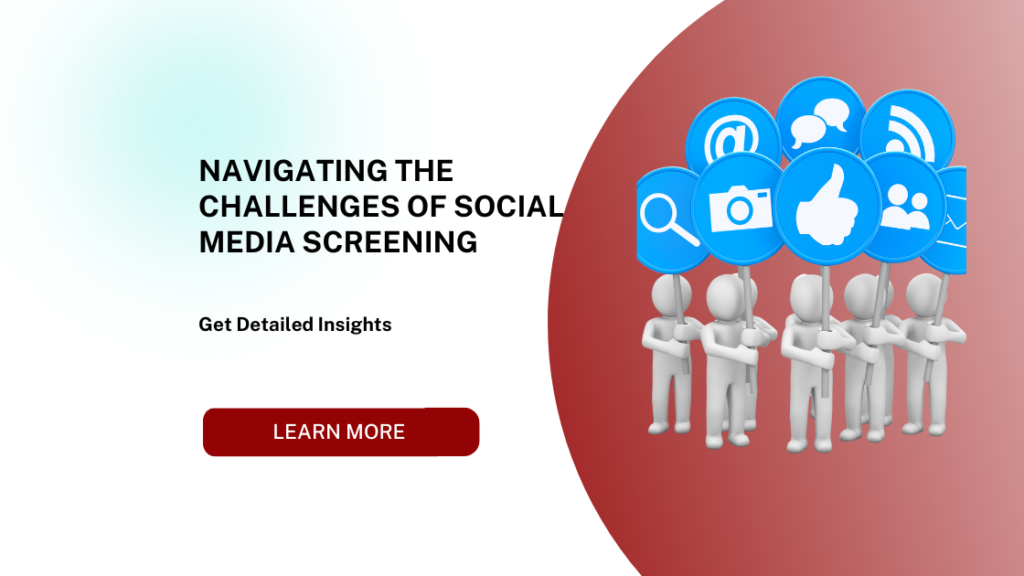
Introduction to Social Media Screening: What it Is and Why It’s Important
Social media screening refers to the process by which employers review publicly available information from a candidate’s social media profiles to gain insight into their character, behaviors, and suitability for a particular job. This screening can involve examining various platforms such as LinkedIn, Facebook, Twitter, Instagram, and other social networks, where candidates typically share both personal and professional content.
Unlike traditional background checks that focus on criminal history or employment verification, social media screening examines a candidate’s digital footprint and interactions. This allows employers to assess how candidates present themselves online and whether their online persona aligns with the company’s values, culture, and reputation.
The importance of social media screening has increased as social media platforms have become central to how individuals communicate, express opinions, and present themselves. What candidates share online can offer valuable clues that traditional references or interviews might not reveal, making social media screening an essential tool in modern hiring practices.
Why Do Businesses Use Social Media Screening?
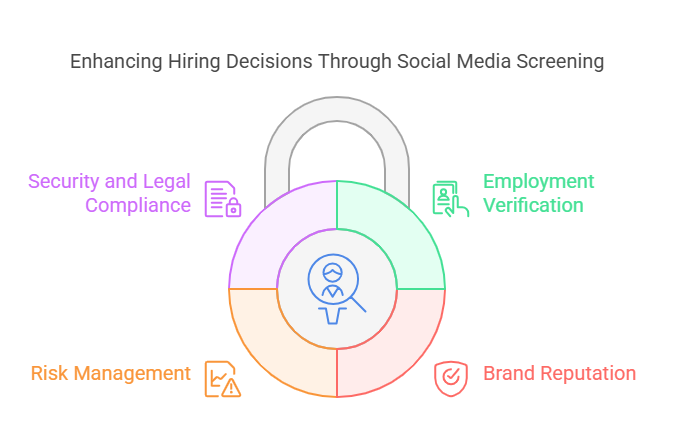
Businesses turn to social media screening for a variety of reasons, which directly impact their decision-making process during hiring. Some of the key reasons include:
- Employment Purposes: Employers can use social media to verify details provided in a candidate’s resume, such as job titles, skills, or affiliations. For instance, LinkedIn profiles can help validate a candidate’s professional history, while personal social media accounts can give insight into a candidate’s interests, personality, and attitude.
- Brand Reputation: As companies increasingly focus on maintaining a positive public image, they want to ensure that their hires do not jeopardize that reputation. A candidate’s social media profiles can offer a glimpse into their personal behavior, opinions, and interactions. If a candidate has a history of posting discriminatory remarks, offensive language, or inappropriate content, it could potentially harm the company’s brand.
- Risk Management: Social media screening helps identify any red flags that might indicate a risk to the company, such as ties to extremist groups, references to illegal activities, or a pattern of aggressive behavior. For example, a tweet or Facebook post that promotes violence or illegal drug use can be a strong signal of a candidate’s potential to cause problems in the workplace.
- Security and Legal Concerns: In certain industries, such as finance, healthcare, or government, ensuring that a candidate has a clean background is crucial to maintaining security and compliance with industry regulations. Social media screening can reveal potential issues, such as past involvement in criminal activities or unethical conduct, that may not be easily uncovered by traditional methods.
Types of Information Employers Look For
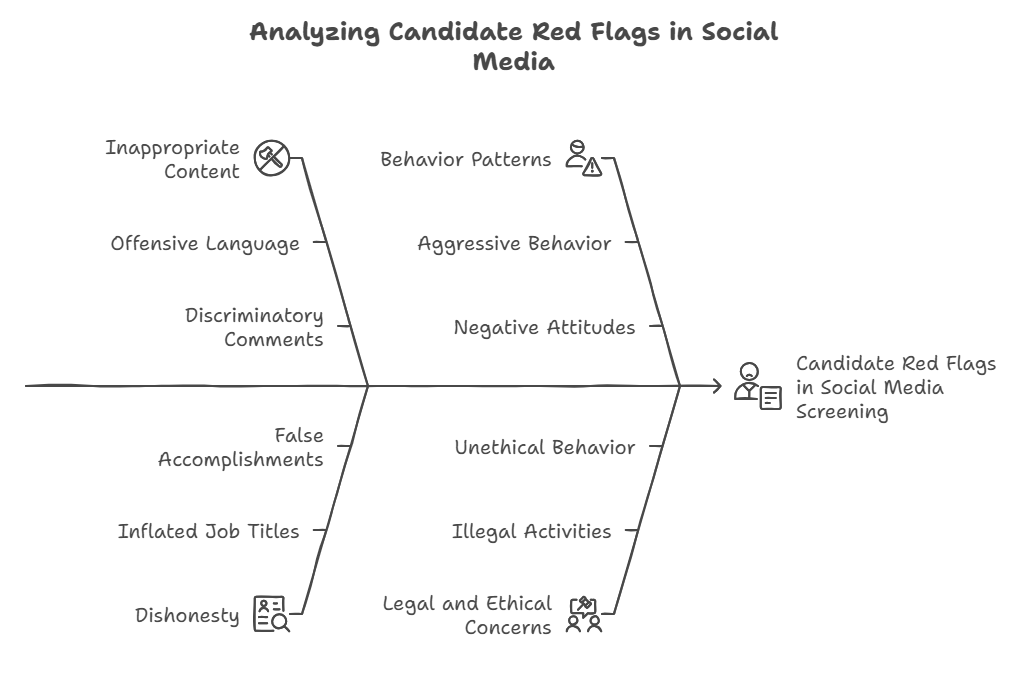
Employers examine various aspects of a candidate’s social media presence during the screening process. Some of the most common types of information that might be flagged include:
- Inappropriate Content: Posts that contain offensive language, discriminatory comments, or hate speech are major red flags. This type of content can be harmful not only to the company’s reputation but also to workplace culture and diversity.
- Dishonesty or Inconsistencies: Sometimes candidates embellish their resumes or lie during interviews. Social media profiles can reveal contradictions, such as inflated job titles, false claims about accomplishments, or gaps in employment history that weren’t disclosed.
- Behavior Patterns: A candidate’s overall behavior and personality can often be inferred from their online activity. Employers may look for signs of aggression, unprofessionalism, or negative attitudes toward former employers, colleagues, or customers. A pattern of these behaviors could suggest the candidate may not fit into the company’s workplace culture.
- Legal and Ethical Concerns: Employers are often concerned about posts that indicate involvement in illegal activities or unethical behavior, such as substance abuse or references to violence. These concerns are particularly critical for businesses in industries that require strict adherence to legal and ethical standards.
How Social Media Screening Works
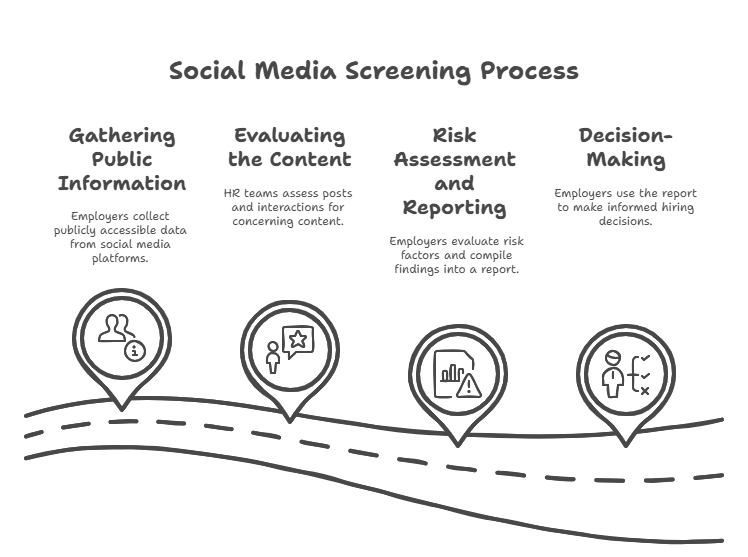
Social media screening typically follows a structured process, although the specific steps may vary depending on the employer’s approach and the tools they use. Here’s a general overview of how social media screening works:
- Gathering Public Information: Employers begin by collecting publicly available information from social media platforms. This includes checking profiles on platforms such as LinkedIn, Facebook, Twitter, and Instagram. Social media screening is based only on the content that candidates have made publicly accessible, ensuring that privacy is respected.
- Evaluating the Content: HR teams or third-party screening services assess the candidate’s posts, photos, comments, and interactions to identify any concerning content. This could include offensive language, controversial opinions, or behaviors that might not align with the company’s values. In some cases, automated tools may be used to help scan large volumes of content quickly, but human review is often necessary for a thorough evaluation.
- Risk Assessment and Reporting: After reviewing the content, employers assess the risk factors associated with a candidate’s online behavior. Red flags may include posts that show signs of aggression, discrimination, or illegal activities. These findings are compiled into a report that helps guide the hiring decision.
- Decision-Making: Based on the information gathered through social media screening, employers make more informed hiring decisions. If a candidate’s online presence raises significant concerns, the employer may choose not to proceed with the hire. Conversely, if no issues are found, the screening may serve as a confirmation that the candidate is a good fit.
Examples of What Might Be Flagged During Social Media Screening
Employers are on the lookout for various types of content that could potentially harm the company’s image or the workplace environment. Some examples of what might be flagged during social media screening include:
- Offensive Language or Hate Speech: Posts that contain racial slurs, discriminatory remarks, or hateful language can be a major cause for concern. This type of content is often seen as incompatible with an inclusive and respectful work environment.
- References to Illegal Activities: Posts that glorify or reference illegal behaviors, such as drug use or criminal activities, are another red flag. Employers are likely to view this as a sign of poor judgment or potentially risky behavior.
- Aggressive or Violent Behavior: Social media profiles that show signs of hostility or violent tendencies—such as threatening comments, verbal aggression, or promotion of violence—are often flagged. Such behavior could translate to problems in the workplace, such as conflicts with colleagues or customers.
- Unprofessional Online Behavior: A history of venting frustrations with past employers or posting negative comments about coworkers or clients could signal a lack of professionalism. This behavior might raise concerns about how the candidate will interact in the workplace.
Why Social Media Screening is Essential for Employers
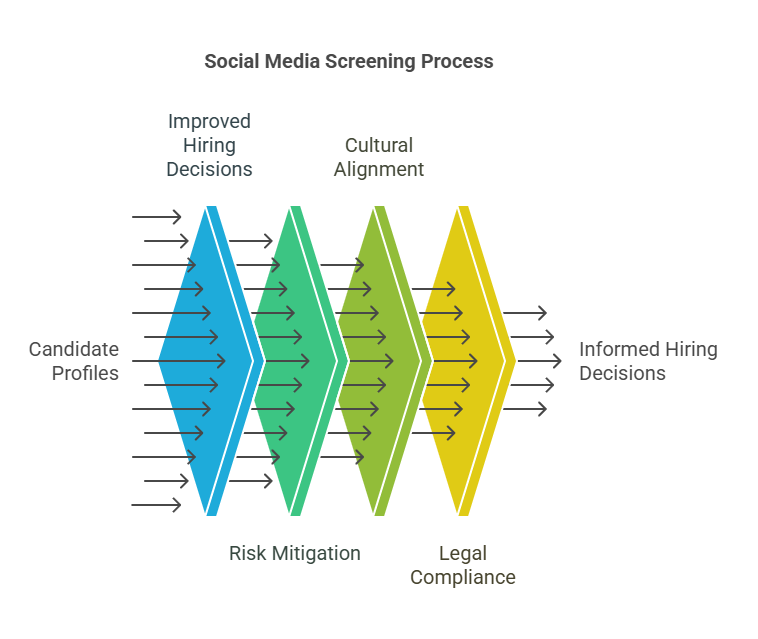
Social media screening is becoming an essential component of the hiring process for employers because it offers a deeper understanding of a candidate’s character, work ethic, and values. Here’s why it is so important:
- Improved Hiring Decisions: Social media screening gives employers additional data points to consider when making hiring decisions. It allows them to gain a better understanding of a candidate’s personality, professional demeanor, and potential red flags.
- Risk Mitigation: By identifying problematic behaviors or attitudes early in the hiring process, social media screening helps employers minimize the risk of hiring candidates who could negatively impact the workplace or damage the company’s reputation.
- Cultural and Value Alignment: Employers want to hire individuals whose values and behavior align with the company’s culture. Social media screening provides insight into how well a candidate’s personal and professional life aligns with the company’s mission, vision, and values.
- Legal Compliance and Security: In certain industries, such as finance, healthcare, or government, social media screening helps ensure that candidates are in compliance with industry regulations and have a clean record. For example, a history of criminal activity or illegal conduct can be flagged during the screening process, helping employers maintain a safe and compliant workforce.
The Process of Social Media Screening: How Employers Evaluate Candidates
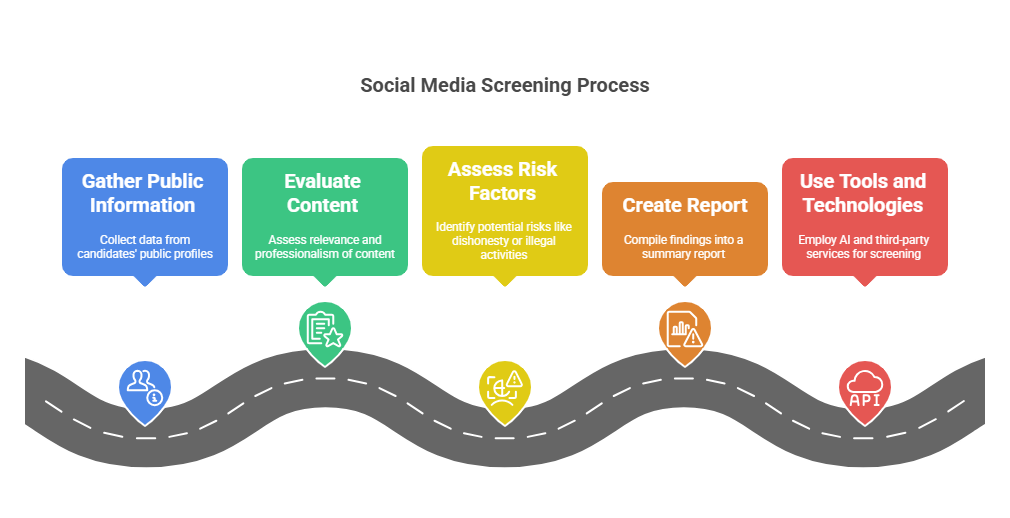
Steps Involved in Social Media Screening
Social media screening is a structured process that enables employers to gather relevant information about a candidate’s online presence. By following specific steps, employers can ensure a fair and thorough evaluation of potential employees. Here is an overview of the typical steps involved in social media screening:
1. Gathering Publicly Available Information
The first step in the social media screening process involves collecting publicly available information from a candidate’s social media profiles. Employers only review the information that is publicly accessible—meaning content that the candidate has not restricted through privacy settings.
Social media platforms commonly screened by employers include:
- LinkedIn: A professional platform where employers can verify job history, education, endorsements, and professional connections.
- Facebook: A platform where candidates often share personal information, opinions, and social interactions.
- Twitter: Known for short posts (tweets), Twitter can provide insight into a candidate’s thoughts, opinions, and social engagement.
- Instagram: A photo and video-sharing platform that can reveal a candidate’s lifestyle, interests, and personal behavior.
- Other Platforms: Depending on the nature of the job, employers may also check platforms such as YouTube, TikTok, and personal blogs.
Employers typically gather all publicly available content that provides insight into the candidate’s behavior, character, and potential fit for the company.
2. Evaluating Content for Relevance
Once the publicly available information has been gathered, employers begin evaluating the content. The evaluation involves looking for potential red flags, as well as confirming information that supports the candidate’s qualifications and professionalism.
During the evaluation, employers focus on:
- Behavioral Patterns: They assess a candidate’s tone, professionalism, and consistency in communication. Posts that showcase positive attributes like teamwork, leadership, and responsibility are valued.
- Content Relevance: Employers focus on content that is relevant to the workplace. This includes assessing whether the candidate’s online behavior aligns with the company’s values and expectations. Content that involves excessive negativity, inappropriate language, or illegal activities may be flagged.
- Professionalism: Employers look for signs of professionalism in how the candidate interacts with others online, their engagement in industry-related discussions, and their portrayal of their professional life.
3. Assessing Risk Factors
One of the key reasons for social media screening is to identify potential risks that a candidate may pose to the company. These risks can range from reputational issues to behavioral problems in the workplace. Employers assess the following risk factors during social media screening:
- Inappropriate or Offensive Content: Posts that contain discriminatory language, hate speech, or violent behavior could indicate a lack of respect for diversity and inclusion, which may be a major concern for employers.
- Dishonesty: If a candidate’s social media posts contradict the information provided on their resume or during the interview, this could indicate dishonesty. For instance, inconsistent employment dates or exaggerated accomplishments can raise doubts about the candidate’s integrity.
- Illegal Activities: Posts or comments that reference illegal activities such as drug use, violence, or other unlawful behavior are major red flags. Such content is typically flagged as a risk because it can create potential legal or ethical issues for the employer.
- Aggressive or Toxic Behavior: A pattern of aggressive or hostile behavior online, such as frequent arguments, insults, or inflammatory language, can signal that the candidate may have difficulty interacting with colleagues, clients, or customers in a professional environment.
4. Creating a Report
After evaluating the content and assessing potential risks, employers compile their findings into a report. This report summarizes key observations, identifies red flags, and highlights areas of concern. The report may also include notes on the candidate’s professionalism, alignment with company culture, and any positive attributes discovered during the screening.
Some employers may use AI-driven software or third-party screening tools to help automate this process and scan for potential risks. However, human oversight is often necessary to ensure that the evaluation is nuanced and considers the context of each post.
Tools and Technologies Used for Social Media Screening
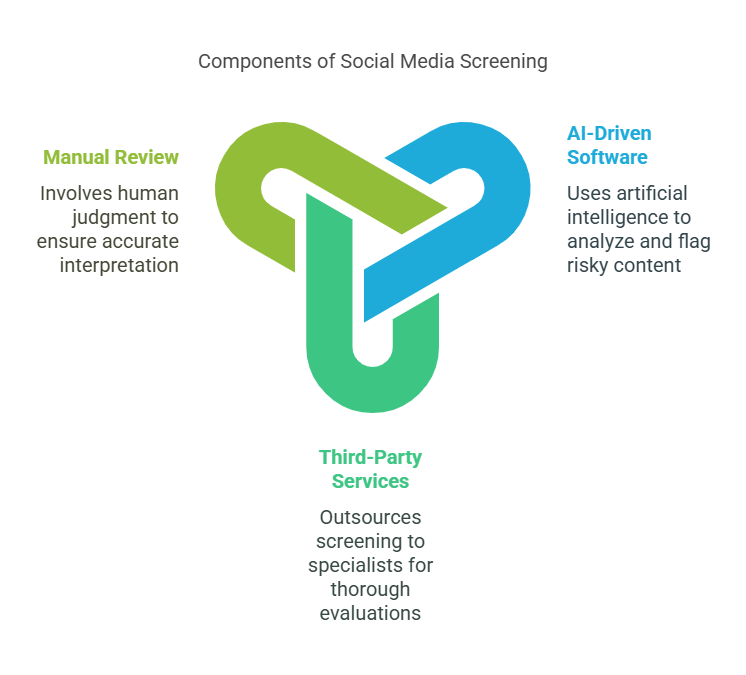
Social media screening is made easier and more efficient with the use of various tools and technologies. These tools help automate the process of gathering, reviewing, and evaluating online content, allowing employers to focus on the most relevant information. Some of the commonly used tools include:
- AI-Driven Software: Artificial intelligence can scan social media profiles for specific keywords, phrases, or patterns that may indicate risk. AI tools can quickly analyze large amounts of content and flag posts that are potentially problematic, such as offensive language, references to illegal activities, or inappropriate behavior.
- Third-Party Services: Many companies opt to outsource social media screening to third-party background check providers. These services specialize in conducting social media screenings and use both automated tools and manual reviews to ensure a thorough and objective evaluation. exactbackgroundchecks, for example, provides businesses with comprehensive social media screening services, allowing them to streamline the hiring process while adhering to compliance standards.
- Manual Review: Although AI tools and third-party services can expedite the process, manual review remains an important part of social media screening. HR professionals or hiring managers manually review content to ensure it’s being interpreted correctly and contextually. Human judgment plays a critical role in determining whether a particular post is truly a red flag or a misunderstanding.
Best Practices for Employers in Social Media Screening
Employers must follow best practices to ensure that social media screening is done effectively, ethically, and in compliance with legal regulations. Below are some essential guidelines for conducting a proper social media screening:
1. Set Clear Screening Policies
Employers should establish clear and consistent policies regarding social media screening. This includes defining the scope of the screening (i.e., which platforms will be assessed), the types of content that will be flagged, and how results will be used in the decision-making process. Clear policies help ensure that all candidates are evaluated equally and that the screening process is not biased.
2. Ensure Compliance with Legal Regulations
Employers must ensure that their social media screening practices comply with applicable laws and regulations, such as the Fair Credit Reporting Act (FCRA), Equal Employment Opportunity Commission (EEOC) guidelines, and state-specific privacy laws. For instance, employers must be careful not to discriminate based on protected characteristics like race, gender, religion, or disability when reviewing a candidate’s social media profiles.
3. Maintain Transparency and Consent
Employers should inform candidates that social media screening will be part of the hiring process. Obtaining consent from candidates is crucial to avoid any legal issues. This can be done by including a section in the job application or providing a separate consent form before conducting the screening.
4. Avoid Bias and Discrimination
Employers should be cautious not to allow personal biases to influence the screening process. Social media content can provide insights into a candidate’s personal beliefs and opinions, but employers must avoid making decisions based on factors unrelated to the candidate’s qualifications for the job. For example, candidates’ posts about political views, religion, or personal lifestyle choices should not be considered unless directly relevant to the position.
5. Balance Privacy and Risk Management
While social media screening is a powerful tool for evaluating candidates, employers must also respect privacy boundaries. Only publicly available content should be assessed, and employers should avoid delving into private areas of a candidate’s social media profiles without their consent. Striking a balance between gathering relevant information and respecting privacy is essential to maintaining ethical practices.
Social Media Screening in Different Industries
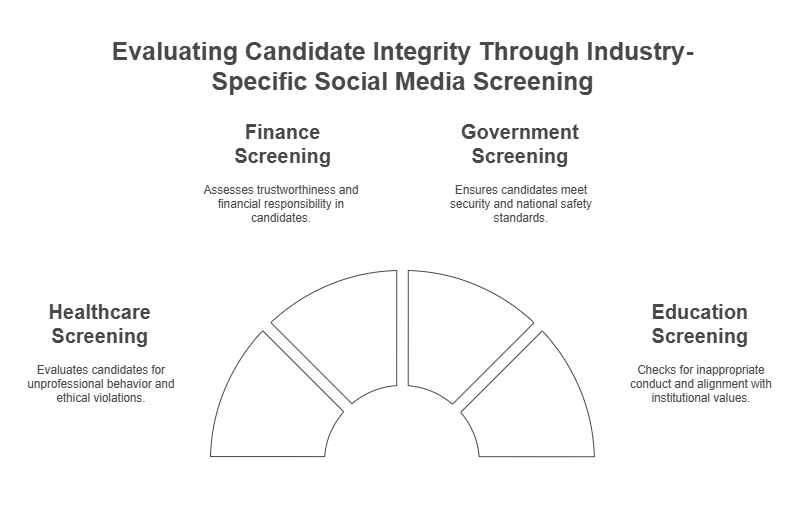
The need for social media screening can vary depending on the industry. Here are a few examples of how different industries use social media screening during the hiring process:
- Healthcare: In healthcare, social media screening is used to assess whether a candidate has a history of unprofessional behavior or ethical violations. Posts that suggest a disregard for patient confidentiality or inappropriate conduct in a healthcare setting could disqualify a candidate.
- Finance: Employers in the finance sector may use social media screening to evaluate candidates’ trustworthiness, financial responsibility, and adherence to ethical standards. A history of reckless behavior or illegal activities could be a disqualifier for positions in banking or finance.
- Government Positions: For government jobs, especially those involving security clearance, social media screening helps ensure candidates do not have ties to extremist groups or criminal organizations. A candidate’s online behavior is carefully scrutinized to ensure national security standards are met.
- Education: Educational institutions often conduct social media screening to assess whether a candidate, especially for roles that work with students, has a history of inappropriate conduct or behavior that might conflict with the institution’s values.
Legal Aspects of Social Media Screening
Social media screening is an essential tool for employers, but it must be conducted within the bounds of the law to ensure fairness and compliance with privacy regulations. Several legal frameworks govern the use of social media screening during the hiring process. Below, we outline the most relevant laws and regulations that employers should be aware of:
1. Fair Credit Reporting Act (FCRA)
The Fair Credit Reporting Act (FCRA) is one of the most important legal frameworks that govern background checks in the United States, including social media screenings when conducted by third-party agencies. Under the FCRA, employers must:
- Obtain written consent from the candidate before conducting a background check (this includes social media screening when outsourced to third-party services).
- Notify candidates if the results of the screening will influence hiring decisions.
- Provide a pre-adverse action notice if a candidate’s social media screening results may lead to rejection or other adverse action.
- Allow candidates to dispute inaccurate or outdated information found in the screening.
Employers must follow these guidelines to avoid violating candidates’ rights and ensure that the social media screening process remains transparent and fair.
2. Equal Employment Opportunity Commission (EEOC) Guidelines
The EEOC enforces federal laws that prohibit employment discrimination. Employers must ensure that social media screening does not lead to biased hiring practices based on race, gender, religion, national origin, disability, or other protected characteristics. Specifically:
- Social media content related to protected categories (e.g., religious views, race, sexual orientation) should not influence hiring decisions.
- Employers must focus on a candidate’s qualifications and behavior that are relevant to the job, rather than personal characteristics or lifestyle choices.
- It’s essential for employers to ensure that their social media screening process does not inadvertently discriminate against any group of candidates.
To avoid discrimination, employers should develop structured guidelines that specify what content will be assessed and how it will influence hiring decisions.
3. State-Specific Privacy Laws
Many states have enacted specific privacy laws that protect the personal online information of individuals. These laws may vary, but they typically require that:
- Employers cannot demand access to a candidate’s private social media accounts (e.g., by asking for login credentials).
- Employers must respect the candidate’s privacy by only screening public social media content.
- Certain states have passed laws that prohibit employers from discriminating against candidates based on their social media activity, especially regarding political views or affiliations.
Employers should stay informed about the specific privacy laws in their state to ensure compliance with all regulations related to social media screening.
4. General Data Protection Regulation (GDPR)
For employers operating in the European Union (EU) or hiring EU-based candidates, the General Data Protection Regulation (GDPR) applies. This regulation focuses on the protection of personal data and requires employers to:
- Obtain clear consent from candidates before accessing any of their personal information (including social media profiles).
- Ensure that only relevant data is collected and used in the hiring process.
- Provide candidates with the ability to access and delete their data if necessary.
- Inform candidates about how their data will be used and stored.
Although the GDPR is a European regulation, U.S. employers with global operations or those hiring EU citizens must adhere to these standards.
Privacy Issues and Risks in Social Media Screening
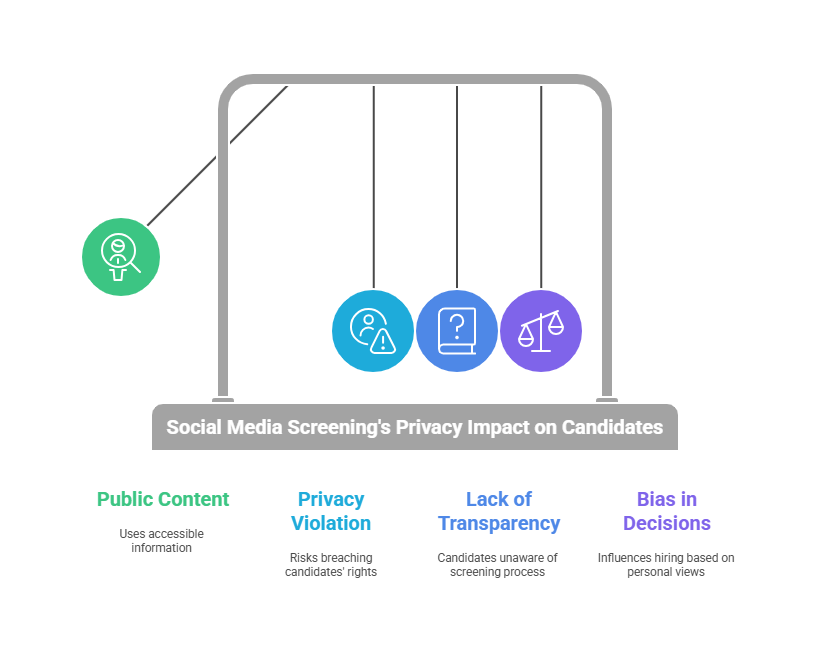
While social media screening provides valuable insights into candidates, it also raises privacy concerns. Employers must be mindful of the following issues:
1. Public vs. Private Content
Only publicly accessible content should be used in social media screenings. This includes information that is visible to anyone on the internet without restrictions, such as posts on public profiles, public group memberships, or comments on public pages. Employers should not attempt to access private content, such as posts behind privacy settings or in closed groups, as this violates candidates’ privacy rights.
2. Transparency and Consent
To protect candidates’ privacy and comply with legal requirements, employers should be transparent about the social media screening process. This includes:
- Informing candidates upfront that their social media profiles will be reviewed as part of the hiring process.
- Obtaining explicit consent from candidates to conduct the screening before proceeding with it.
- Allowing candidates to review the results of their social media screening if it leads to adverse actions such as a job rejection.
3. Minimizing Bias
Employers should ensure that personal biases do not influence the decision-making process. For example, a candidate’s posts about hobbies, political views, or lifestyle choices should only be considered if they are directly relevant to the job position. Focusing on behavior that directly impacts work performance, cultural fit, or potential legal risks helps mitigate the chances of bias during screening.
Frequently Asked Questions (FAQs) About Social Media Screening
What is social media screening and why do businesses use it?
Social media screening is when employers review a candidate's public social media profiles to assess their character and suitability for a job. Businesses use it to verify resumes, protect their brand, manage risks, and address security concerns.
What types of information do employers look for during social media screening?
Employers look for inappropriate content, dishonesty, behavioral patterns, and legal/ethical concerns, such as offensive language, inconsistencies in resumes, signs of aggression, and references to illegal activities.
How does social media screening work?
It involves gathering public information, evaluating content, assessing risk factors, and creating a report to inform hiring decisions.
What are the legal aspects to consider when conducting social media screening?
Employers must comply with the Fair Credit Reporting Act (FCRA), Equal Employment Opportunity Commission (EEOC) guidelines, state-specific privacy laws, and, if applicable, the General Data Protection Regulation (GDPR).
Why is social media screening essential for employers?
It improves hiring decisions, mitigates risks, ensures cultural and value alignment, and helps maintain legal compliance and security.
What is social media screening and why do businesses use it?
Social media screening is when employers review a candidate's public social media profiles to assess their character and suitability for a job. Businesses use it to verify resumes, protect their brand, manage risks, and address security concerns.
What types of information do employers look for during social media screening?
Employers look for inappropriate content, dishonesty, behavioral patterns, and legal/ethical concerns, such as offensive language, inconsistencies in resumes, signs of aggression, and references to illegal activities.
How does social media screening work?
It involves gathering public information, evaluating content, assessing risk factors, and creating a report to inform hiring decisions.
What are the legal aspects to consider when conducting social media screening?
Employers must comply with the Fair Credit Reporting Act (FCRA), Equal Employment Opportunity Commission (EEOC) guidelines, state-specific privacy laws, and, if applicable, the General Data Protection Regulation (GDPR).
Why is social media screening essential for employers?
It improves hiring decisions, mitigates risks, ensures cultural and value alignment, and helps maintain legal compliance and security.
Conclusion
Social media screening has become a crucial tool for employers to make informed hiring decisions, assess potential risks, and evaluate a candidate’s alignment with company values. However, it’s essential that employers conduct social media screening in a way that is legal, ethical, and transparent. By adhering to best practices and understanding the legal landscape, employers can mitigate risks while respecting candidates’ privacy and ensuring fairness throughout the hiring process.



